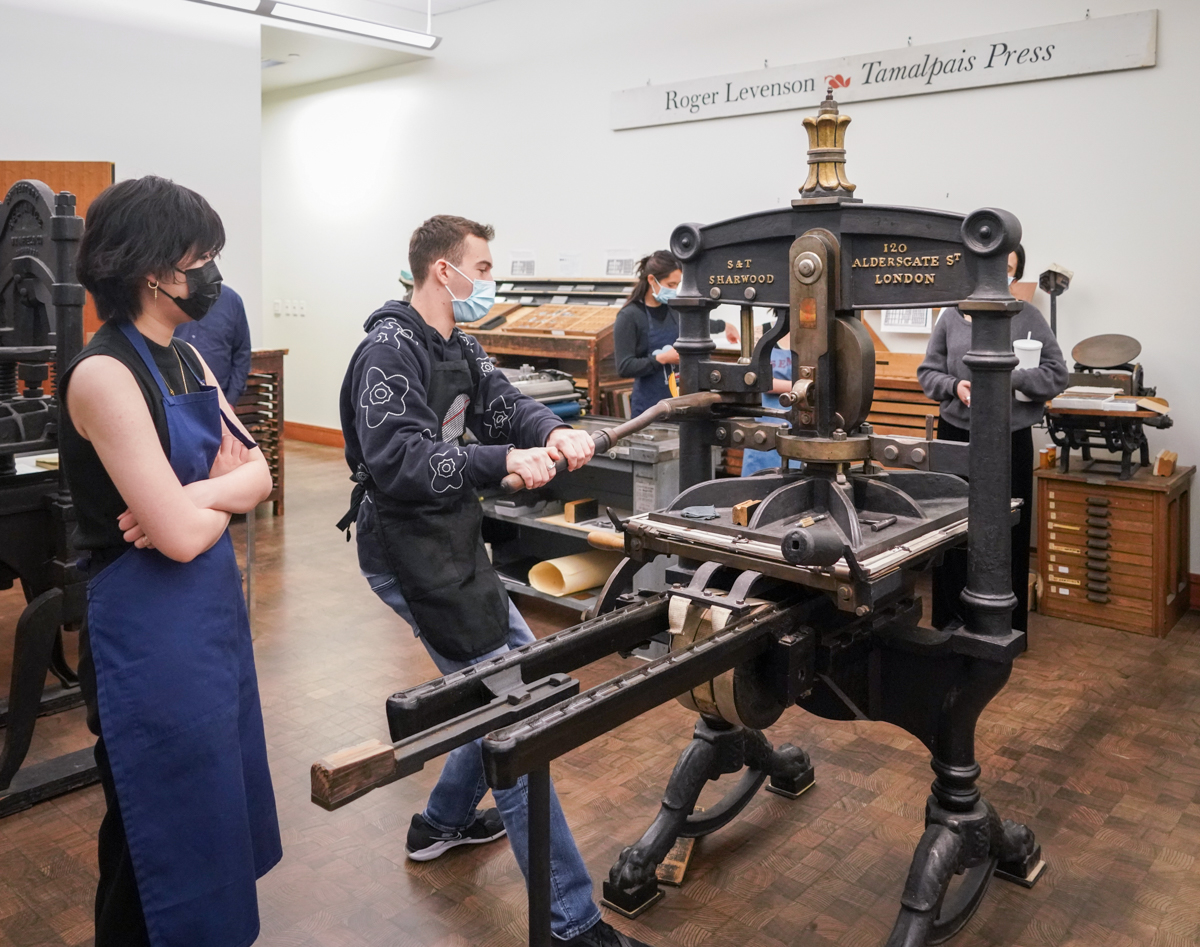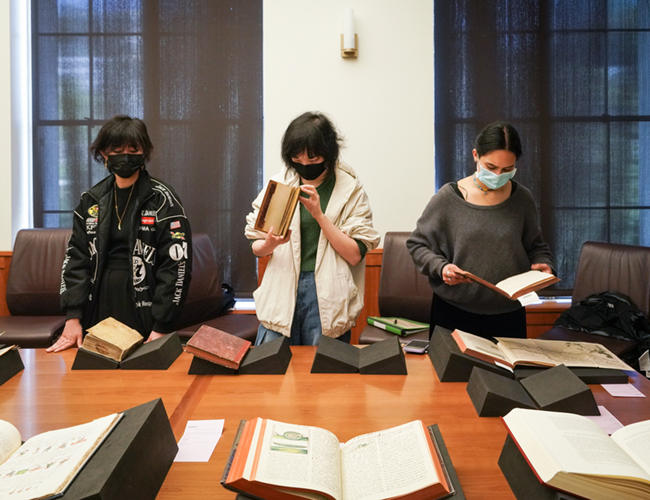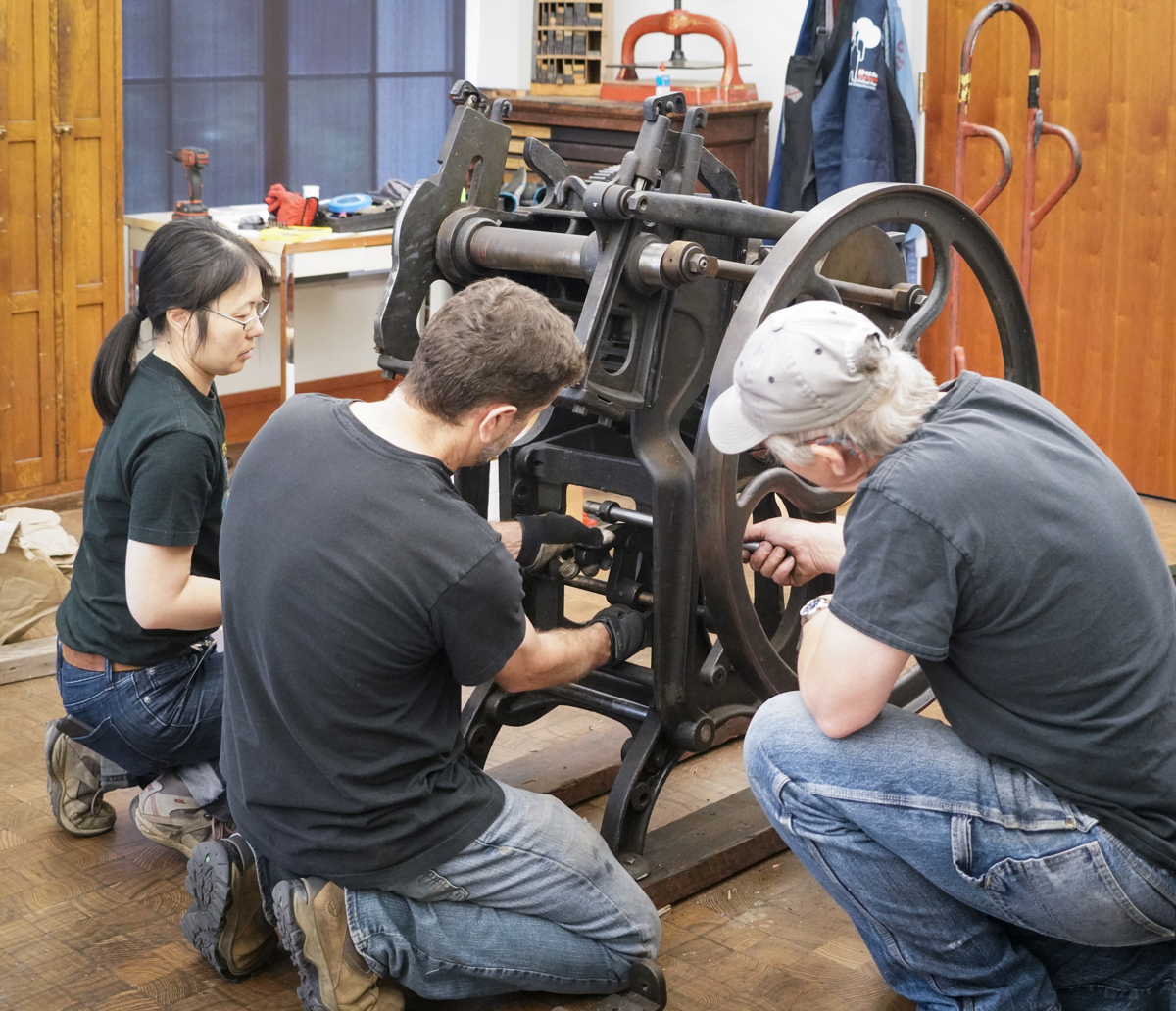
How did a class about the history of hand-printed books get so popular?
Because it leaves an impression.
Math student David Awakim discovered the elective on a Reddit thread about can’t-miss classes at UC Berkeley. He was drawn to the idea of working with his hands, and learning how to use a vintage printing press to create something tangible — a welcome change from the abstractions of his upper-level math classes.
“It’s so fun to actually translate something that we do to a physical change on a paper,” he said. “Seeing, like, I put in this work, I get this result out of it. You know, seeing a stack of full proofs develop. Seeing the actual ink fresh on the page. I think all of that is really cool.”
“The Hand-Printed Book in Its Historical Context,” held in The Bancroft Library’s press room, celebrates its 40th anniversary this year. Since 1983, the course has given students the opportunity to experience the history of books, from design to printing to publishing. The class culminates in the students printing and hand-binding 50 copies of an original book, one of which becomes part of Bancroft’s permanent collection.
Inge Bruggeman, a lecturer in the Undergraduate Interdisciplinary Studies teaching program, has taught the class for the past four semesters. She said the course’s staying power comes from the appeal of applied learning. For many students, who are accustomed to simply clicking “print” on a screen, there is a special thrill in pulling the lever on an 1856 Albion hand press.
“(Classes such as these) can be some of the most satisfying and impactful,” Bruggeman said. “This style of learning is the kind that really sticks with students long term.”
For Kate Donovan, director of The Bancroft Library, the class represents the full scope of what instruction looks like in the library.
“Students are not just looking at something, they’re interacting with the physical object,” she said. “And then they’re learning about its production and … how that production informs the movement of information and knowledge over time. And they get to experience all that, literally, firsthand.”


Course contents
Each session of the class is organized into halves. In the first, students get up close with rare and fragile books from the library’s collection that span 600 years. The semester starts with samples of proto-books from before Europe’s printing revolution and concludes with contemporary artists’ books.
Bruggeman said the class focuses primarily on the history of printed books in Europe but does touch on the evolution of books worldwide, from scrolls of papyrus and silk to palm-leaf manuscripts and more.
Awakim has been wowed by many of these items, but none more so than a first-edition copy of Euclid’s seminal mathematics text Elements of Geometry, printed in 1482. The original handwritten work dates back to about 300 B.C.E.
Bancroft curators lead some of these learning sessions. José Adrián Barragán-Álvarez, the library’s curator of Latin Americana, for example, has visited the class to present rare books from the Latin Americana Collection and to discuss early printing in the Americas.
The second half of each session is when students get their hands dirty, learning to set type and apply ink. This semester, the class of 10 is printing its books on the aforementioned Albion hand press and the Vandercook proof press (from 1961).
Bruggeman selects the theme for each semester’s book, often in consultation with curators. This semester, the project complements Voices for the Environment: A Century of Bay Area Activism, an immersive exhibit on display in the library’s gallery. The finished book will highlight three environmental justice leaders: Carl Anthony, Henry Clark, and Pamela Tau Lee.
“I try to pick materials that are relevant to the students’ lives in some way,” Bruggeman said. “Environmentalism, racism, and economic injustice are relevant contemporary issues, and perhaps, we can learn something from those that came before us.”
Last spring, the students printed three unpublished poems from the acclaimed writer Jessica Hagedorn, whose papers are held by Bancroft.
Room to grow
Future students in the class will have another tool at their disposal, thanks to the recent addition of a Chandler & Price printing press from the early 1900s. The library received the press as part of a bequest from rare book collector William P. Barlow Jr. ’56.
“The press is significant because it complements our existing collection,” said David Faulds, Bancroft’s curator of rare books and literary manuscripts, “and gives students a chance to see and experience the transition of (printing) technology over time.”

Barlow, who was a Friend of The Bancroft Library and proud supporter of UC Berkeley, also donated a vast cache of books and ephemera. Faulds described the gift as the largest of early printed books the library has received since the 1950s.
Barlow’s collection contains a cornucopia of items relating to John Baskerville, a renowned 18th-century English printer and typographer whose serif typeface is still in use today. Faulds said the collection of Baskerville’s work is among the best in the world, and includes rare letters and pamphlets.
Travel guides by Duncan Hines from around the mid-20th century are another highlight of the collection. The guides document food and lodging options for states across the country. Barlow also collected ephemera related to these establishments, such as menus, matchbooks, and even roadside signs. All told, this slice of Americana has immense value for researchers interested in the period, according to Faulds.
Donovan sees the generous gift as a way to offer more pathways into the library. She has made access to Bancroft’s materials one of her top priorities.
As for the new printing press, she believes it will strengthen an already exceptional press room, and serve as an impetus to activate the space in new ways.
“The press room is one of the jewels of The Bancroft Library,” she said. “My goal is to have open workshops in that space, not just for students in the class, but for all students, and Library staff.”
She envisions students using the presses in some of the same ways earlier generations did — to print poetry chapbooks or protest posters. With the latest press acquisition, one of the other machines was moved into the library’s lobby. Donovan would like to host events in that area, where donors and others can see the press in action.
The experience will surely impress, as it has for students in “The Hand-Printed Book in Its Historical Context.”
“We have these printing presses here, and they don’t really get produced anymore,” Awakim said. “You know, they’re a really scarce resource. And you have expertise here. You have a really supportive environment, and it’s just a once-in-a-lifetime chance to actually get to see this and work with it.”